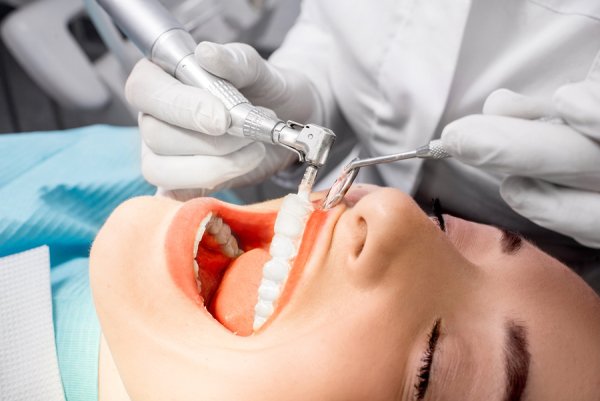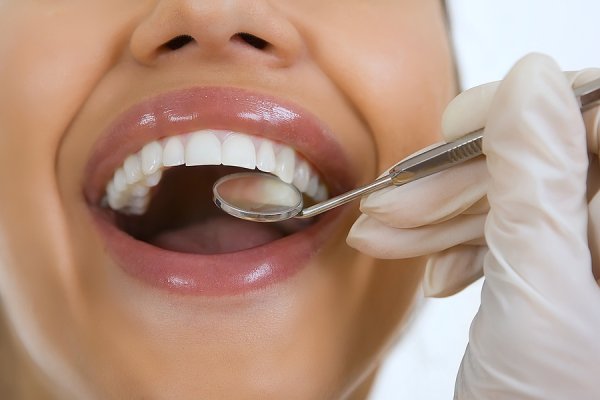-
Taking Your Child to the Dentist
Once your child develops his first tooth, he’ll need to begin visiting a family dentist near you in St. Louis for regular dental care. Your family dentist can provide teeth cleaning, preventative dental care, and oral health screenings to ensure your child doesn’t develop cavities. The earlier your child is when he begins visiting the dentist, the less likely he is to suffer from dental fears later in life.Watch this video to learn more about the importance of regular dentist visits for your child. Your child will learn good oral hygiene habits, and will receive professional dental care, reducing his future risk of cavities, tooth decay, gum disease, and tooth loss.
Many parents are under the impression that they need to take their child to a pediodontist to get the care they need, but this isn’t true! Dr. Spalitto regularly treats children ages two and up! Bring your family in to see the awesome team at West County Dental.
-
Answers to Your Questions About Laser Dentistry

Have you been to the dentist in St. Louis and noticed that your dental professional is using a laser? Most people have, but laser dentistry still remains a mystery to most.
Dr. Spalitto’s team at West County Dental wants to help you understand the process of laser dentistry by answering some of the common questions about the procedure.
What is Laser Dentistry?
Laser dentistry is exactly what it sounds like. It uses lasers during dental work procedures. Lasers have been used in dentistry since the 1990s. Using lasers allows your dentist to produce a beam of light energy that causes your tissue to react. It allows your dentist to shape or remove tissue safely and accurately in your mouth.What Are Lasers Used For?
If you have tooth decay, lasers can be used to prepare your tooth for a filling. Lasers are also useful to harden a filling once it is placed. If you have some stage of gum disease, Dr. Spalitto can use a laser to shape your gums and remove any bacteria. Another common use for lasers is during a root canal. They are able to remove bacteria during the procedure. Lastly, a dental professional uses a laser to whiten your teeth. The lasers speed up the whitening process.How Does Laser Dentistry Work?
Laser dentistry is used in so many dental procedures that it would be difficult to explain each one. However, here are a few explanations. During an in-office tooth whitening, for example, a laser is a heat source that reacts with the topical whitening agents to make them activate quicker. And in the case of surgery, a laser is used as a cutting instrument.What are the Benefits of Laser Dentistry?
Laser dentistry is wonderful because in many cases it can decrease the pain of a procedure and reduce the need for a patient to receive anesthesia. Less blood during soft tissue procedures is also a benefit of laser dentistry. The main benefit of laser dentistry is that is can act as a replacement for a dental drill, meaning less noise and anxiety. -
Dealing With a Dental Emergency
You never know when you will have a dental emergency, but knowing what to do in an emergency situation can help your dentist who practices family dentistry in St. Louis save your beautiful smile. Watch this video to inform yourself about how to deal with a dental emergency appropriately.
Sports injuries, falls, and other accidents can all lead to a dental emergency. If you find yourself in one of these situations, first apply a cold compress to your cheek where the injury occurred. After this step is completed, rinse your mouth with warm water. If you bit your tongue, lip, or cheek, seek immediate medical attention if the bleeding does not stop. Also, if you believe you broke your jaw contact a professional immediately. If your tooth falls out due to an injury be sure to keep it moist in a glass of water or milk, or in its original tooth socket until you can get to the dentist office.
At West County Dental, Dr. Spalitto typically fits dental emergencies into his schedule and treats them all in the same day!
-
What Are Same Day Crowns?

Fitting dental procedures into your daily life can seem like a hassle. Fortunately, your dentist in St. Louis , Dr. Spalitto, is able to provide a same day crown procedure at his family dentistry office. If you have a busy schedule and need dental work, read on to learn about same day crowns.
Often times, getting a new crown can take multiple visits to your dentist. Fortunately, Dr. Spalitto uses advanced dental technology to provide you with a new crown or veneer in one visit. Using a 3-D camera of your existing tooth, Dr. Spalitto is able to use computer-assisted design and computer assisted milling, also known as CAD-CAM, to create a new crown or veneer in the office. After the creation of the crown or veneer, it will be fixed into place. In a single session you can be done with your family dentistry visit and back to your normal life with a beautiful, healthy smile.
One happy customer found West Count Dental online and was in need of a crown. The team was able to get her in the very next day, and do a root canal and crown within the same day! She lived over 70 miles away, and the convenience of a same day crown made it worth her drive. If you are in the St. Louis area, and you need a root canal or a crown, don’t hesitate to experience the technology Dr. Spalitto has for same-day procedures.
-
The 411 on Root Canals [INFOGRAPHIC]
Root canals are performed to save teeth when the dental pulp has become severely decayed or when a nerve has become infected. You may need a root canal if you have a large cavity that has gone untreated, you have a cracked tooth, or you have had repeated deep dental procedures on the same tooth. When patients find out that they need a root canal, they are often apprehensive because of what they have heard about root canal pain. In reality, root canals are as easy for patients as fillings, and a local anesthetic or sedation dentistry will keep you comfortable throughout the procedure. Learn more about root canals in this infographic from West County Dental. Choose our practice when you need a dentist near St. Louis for preventative care and your general dentistry needs. Root canals are extremely common, so help others understand the facts behind the procedure by sharing this helpful information.

-
A Look at Dental Health in Seniors

Having a healthy smile is important for your overall health. While taking care of your oral health is always important no matter your age, it becomes vital as you get older. Working with Dr. Spalitto, who practices family dentistry in St. Louis , can help you maintain great oral health as you age. Here are some of the top dental health concerns for senior citizens.
Periodontal Disease
People over the age of 60 are at higher risk for periodontal disease than people of a younger age. Periodontal disease can cause red, inflamed, and bleeding gums, and also tooth loss in severe cases. About a quarter of adults ages 65-74 have had a diagnosis of severe periodontal disease. Men, more so than women, are at risk for a severe diagnosis. Regular visits to Dr. Spalitto’s family dentistry clinic in St. Louis can help you keep your gums healthy as you age.Decay
Just as with periodontal disease, your risk of tooth decay increases with age. In particular, those who did not have access to fluoride in their water growing up are diagnosed more often with issues of decay. One quarter of adults in America over the age of 60 no longer have their adult teeth. Older people will continue to have decay on the crowns of their teeth and on the tooth roots, unless they have been removed during a root canal procedure. Adults over the age of 60 see tooth decay more so than children. Having missing teeth due to severe decay can cause pain when chewing food and it can become difficult to speak properly, not to mention can make you feel insecure about your smile.Cancers
Oral and pharyngeal cancers are a very real risk for people over the age of 60. Over 30,000 people a year are diagnosed with these types of cancer and many of them are above 60 years old.Insurance
Being that dental insurance is not covered under most health insurance policies, many adults over the age of 60 are not covered. Medicare, which gives people over the age of 65 health insurance, does not cover dental work either. If you are over 60 and need dental work, Dr. Spalitto and his team at West County Dental would love to talk with you to see how he can help you gain a healthy, beautiful smile with affordable financing options. -
Spotlight on Single Tooth Replacement

You may think a missing tooth is no big deal; the reality of the situation, however, is that you may experience several consequences if you do not have it replaced by your dentist in a timely fashion. Fortunately, Dr. Spalitto, a dentist in St. Louis , has a great deal of experience in restorative dentistry and is happy to help by placing a dental implant. Continue reading if you would like to learn about the benefits and process involved in a single tooth replacement.
Whether you are missing all of your teeth, some of your teeth, or just one of your teeth, replacement is important. Replacing a missing tooth allows healthy neighboring teeth to stay in the right position rather than shifting into the newly opened gap. It also helps your jaw retain bone mass. Dental implant placement is a common dental procedure that aims to replace your natural tooth with a similar prosthetic one, root and all. After your dentist installs the implant into your jaw, he will cover it with a dental crown so you can enjoy an efficient replacement tooth.
-
Understanding Your Teeth Whitening Options

If your teeth have lost their shine over the years and you would like to enjoy a bright smile once again, you may be interested in teeth whitening treatment. Dr. Spalitto, a skilled dentist in St. Louis, is happy to help you achieve a smile that looks as healthy and youthful as ever. Teeth whitening treatment is among the least invasive and simplest treatments that dentistry has to offer. Read on for help in understanding your teeth whitening options.
In-Office Whitening Procedures
Many people are unaware that a teeth whitening procedure is an available treatment at all until they meet with their dentists to find out how they can enjoy a brighter smile. If you have never whitened your teeth before, you may want to do so under supervision from a dentist in order to ensure optimal results. Procedures conducted in the dentist’s office may also make use of more powerful products and yield more noticeable results than those you could perform yourself. Your dentist can protect your gums with a special guard to ensure that these powerful products are applied only to your teeth. He or she can also use a heat source to catalyze the teeth whitening process.Home Whitening
If you decide to whiten your teeth at home, you will not use the same products or approach that your dentist would use in the office. Instead, you will typically use a mouthpiece tray that he has created specifically for your teeth. You will add a whitening gel to your custom mouthpiece tray and wear it for a few hours each day. The tray should keep the whitening agent away from your gums since it has been customized for your mouth. You can also find over-the-counter whitening kits at convenience stores, but they may not fit or work as well.Whitening Strips
Another form of teeth whitening treatment is whitening strips. You can apply these gel-coated strips to your teeth twice each day for 30 minutes at a time. After about two weeks, you should experience the end result, which will typically last for about four months afterwards. -
How to Brush Your Teeth
When you visit Dr. Spalitto, your dentist in St. Louis , he will screen you for an array of complications, clean your teeth, and evaluate your need for dental restorations like root canals or tooth extractions. It is important, however, to understand how to brush your teeth properly outside of the dentist’s office. Watch this video for an overview of how to brush your teeth.Brushing your teeth is the cornerstone of dental hygiene, and yet many people are misinformed about the proper techniques. Whether you use a power brush or a manual brush, you should brush your teeth twice each day. Hold your toothbrush at a 45-degree angle to your gums and gently brush away from the gums on each section of your teeth. You should spend 30 seconds on each of the 4 quadrants of your mouth.
-
Dental Implants for Denture Patients

There are a few different ways you can go about treating missing teeth. Many individuals seek dental implants in St. Louis from a dentist such as Dr. Spalitto of West County Dental, while others prefer to go with the more traditional route of conventional dentures. While each of these forms of treatment has its own benefits and drawbacks, some people may be interested in a combination of the two—implant-supported dentures. Keep reading if you are interested in learning more about dental implants for denture patients.
Dentures
In the past, a set of dentures was the go-to treatment for people who had missing teeth. This treatment allows individuals to go from having zero teeth to having a full set of prosthetics in a short amount of time. With the proper fit and adhesive, those who wear dentures can enjoy a successful treatment that improves their appearance and restores function. This treatment plan does come with drawbacks, however. Proper fit and adhesive can help, but they are not always so easy to achieve. Dentures may become ill fitting over time, and it may be a while before the wearer realizes that this has occurred. They may also slip around or fall out of your mouth without the proper adhesive.Implants
Dental implants can effectively revitalize your teeth, gums, jaw, and even facial appearance. During this treatment, your dentist will place an implant in your jawbone with a post that protrudes through your gums. You will then receive a cap or dental crown to place on the end of the post. This procedure provides patients with effective prosthetic teeth that do not move around or lose their fit.Implant-Supported Dentures
Those who cannot help but seek the best of both worlds may be interested in implant-supported dentures. Using just a few implants, your dentist can offer you a permanent denture that will stay perfectly still in your mouth. This means that you will not have trouble chewing your food or having a conversation with your friends and family. Your dentist will typically place the implants in the front of your jawbone, where there tends to be more mass.
RECENT POSTS
categories
- Uncategorized
- crowns
- dental veneers
- dentists
- full service dental practice
- porcelain veneers
- same day crowns
- Dental Cosmetic Surgery
- Dental Implants
- Dentistry
- Dentist Review
- Laser Dentistry
- Root Canal
- Sedation Dentistry
- Dentures
- Cleanings
- Teeth Whitening
- Abscessed Teeth
- Cosmetic Dentistry
- Infographic
- Cavities
- Sealants
- Gum Recession
- Periodontal Disease
- Dental Health
- Family Dentistry
- Dental Emergency
- Invisalign
- Filling
- Same Day Dental Procedures
- Gum disease
- Sleep Apnea
Archives
2022
2021
- December (2)
- November (1)
- October (3)
- September (2)
- August (2)
- July (2)
- June (2)
- May (2)
- April (2)
- March (2)
- January (2)
2020
2016
2015
- December (4)
- November (3)
- October (3)
- September (4)
- August (4)
- July (4)
- June (4)
- May (3)
- April (3)
- March (4)
- February (5)
- January (6)

